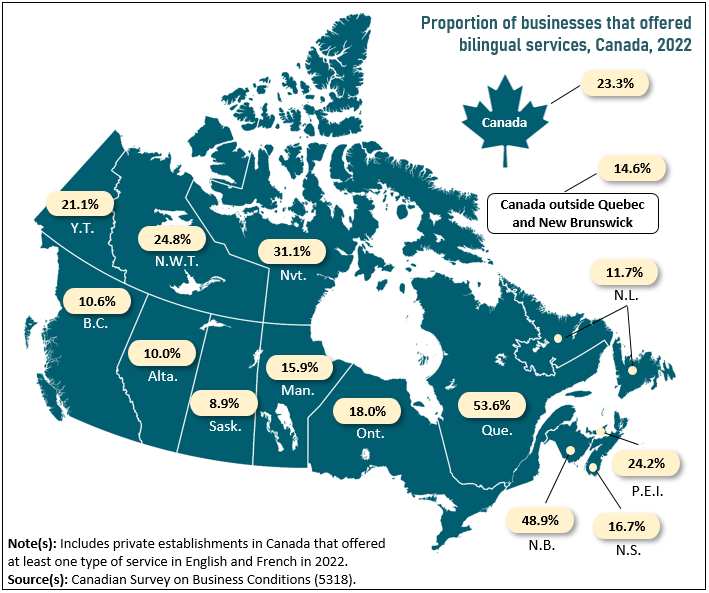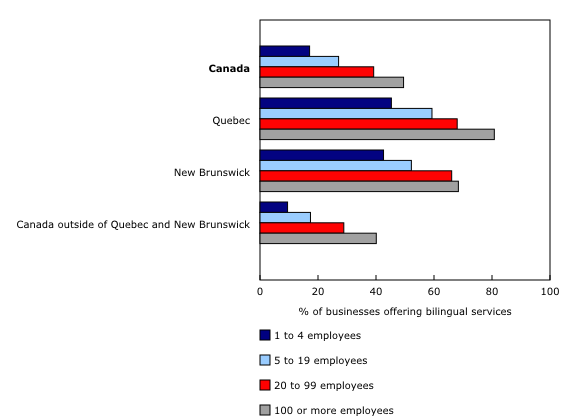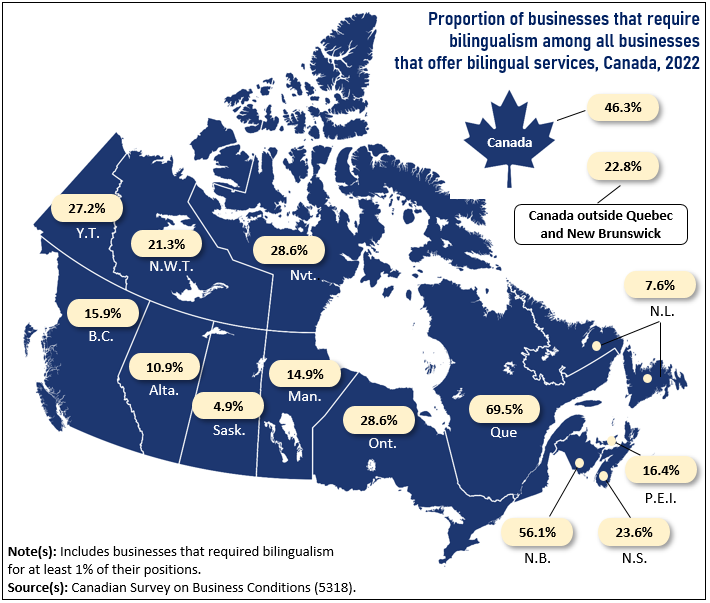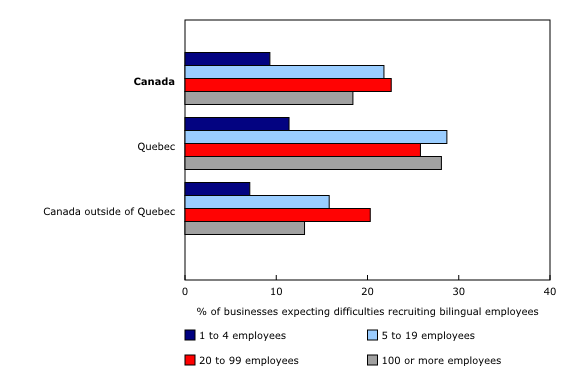Almost one in four businesses offers at least one type of service in English and French
Released: 2023-06-01
In the summer of 2022, Canadian labour market indicators were pointing to a labour shortage, as employment had surpassed its pre-COVID-19 pandemic levels in the fall of 2021. The job vacancy rate peaked at 5.9% in May 2022, while the unemployment rate saw a historic low of 4.9% in June and July 2022.
In this context, three new questions on language of service, the positions requiring bilingualism, and shortage of bilingual labour in the private sector were added to the questionnaire for the Canadian Survey on Business Conditions (5318), conducted from July to August 2022. This survey collects information on the activities of businesses and the obstacles they face or expect, such as recruitment problems related to the labour shortage.
Private business establishments can, for example, offer customer service, signage or a website in English and French, or conduct internal and external communications in Canada's two official languages. In 2022, more than 250,000 private business establishments (23.3%) in Canada offered at least one type of bilingual service or conducted at least one business activity in both English and French.
However, variations were observed, for example, by business size. About one in six (17.1%) businesses with one to four employees offered some bilingual services, compared with nearly half (49.5%) of establishments with 100 or more employees. All businesses that offered bilingual services employed 41.0% of the workforce in Canada's private sector.
In 2022, roughly 1 million positions in Canada's private sector required bilingualism, even though more than 60,000 businesses expected recruiting bilingual employees to be an obstacle. Private sector businesses are defined as non-governmental businesses, whether for-profit or not-for-profit.
More than 250,000 businesses in Canada offer at least one bilingual service
Of the 1,082,000 private business establishments in Canada in 2022, 252,000 (23.3%) offered some bilingual services, meaning that they offered at least one type of service or reported at least one business activity that took place in both English and French.
However, the national proportion is not representative of the offer of services in both official languages, which varies considerably between the provinces and territories.
Roughly half of businesses in Quebec (53.6%) and New Brunswick (48.9%) offered at least one bilingual service, versus about 1 in 10 businesses in Western Canada—Saskatchewan (8.9%), Alberta (10.0%), and British Columbia (10.6%)—and in Newfoundland and Labrador (11.7%).
Looking at the geographic distribution across Canada of businesses offering bilingual services, just over half (51.6%) were located in Quebec (47.4%) and New Brunswick (4.2%). This means that almost half (48.4%), or more than 122,000 business establishments offering some bilingual services, were distributed throughout the rest of the country.
In terms of labour, all businesses that offered at least one type of bilingual service accounted for 41.0% of jobs in Canada's private sector.
In Canada, larger businesses were more likely to offer bilingual services than smaller businesses. About one in six (17.1%) businesses with one to four employees offered some bilingual services, compared with nearly half (49.5%) of establishments with 100 or more employees. It should be noted that the vast majority (98.1%) of businesses are small businesses with less than 100 employees.
Bilingual services offered in the private sector also varied by the type of service or business activity in 2022. Of businesses that provide customer service, 16.2% offered this service in both official languages. This represents nearly one in six businesses that offered bilingual services to their customers.
Meanwhile, 13.3% of businesses reported offering bilingual sales, and 11.7% provided customers with a bilingual website, if they had a site. Similarly, 9.2% of businesses that reported marketing and advertising, or other external communications offered them to the public in Canada's two official languages.
In contrast, 6.6% of businesses reported providing internal communications in both English and French. Providing bilingual internal communications encourages workers to use both official languages at work. Lastly, indoor signage (6.5%), outdoor signage (4.8%) and export activities (2.7%), if any, were also least likely to be bilingual.
More than 4 in 10 businesses in Quebec (43.2%) and New Brunswick (40.8%) offered bilingual customer service. Over one-third of the businesses in these two provinces (37.2% in Quebec and 34.2% in New Brunswick) provided sales in both official languages, and more than one-quarter (31.8% and 25.3%) had a bilingual website. This compares with fewer than 1 in 10 businesses in the rest of Canada for each type of service or business activity.
In Quebec, businesses in the wholesale trade (79.8%), manufacturing (78.0%), arts, entertainment and recreation (68.8%) and retail trade (65.2%) industries were more likely to offer some bilingual services or to report conducting business activities in both official languages. Conversely, businesses in transportation and warehousing (42.7%), construction (31.4%) and agriculture, forestry, fishing and hunting (26.2%) were the least likely.
In New Brunswick, the highest proportions of businesses that offer some bilingual services were in arts, entertainment and recreation (76.2%), finance and insurance (70.7%), accommodation and food services (67.9%), manufacturing (65.1%) and retail trade (60.8%), while the lowest rates were in transportation and warehousing (27.6%) and construction (35.5%).
In the rest of the country, the highest proportions of businesses that offer some bilingual services were in the wholesale trade (32.0%), information and cultural industries (30.9%), finance and insurance (25.0%) and retail trade (18.4%) industries. Meanwhile, the lowest percentage was observed in agriculture, forestry, fishing and hunting (6.1%).
About 1 million positions in Canada's private sector require bilingualism
In 2022, approximately 1 million (7.9%) positions in businesses in Canada required bilingualism (English and French), according to respondents' estimates.
Quebec had the highest number of positions requiring bilingualism in the private sector (almost 750,000 bilingual positions) in 2022, representing just over one-quarter (25.6%) of jobs in businesses in the province. This proportion was also high in New Brunswick (18.5%), where nearly 50,000 private sector positions required bilingualism in the province's two official languages.
In the rest of Canada, more than 275,000 positions (2.7%) required bilingualism, including more than 180,000 (3.5%) in Ontario, around 15,000 (3.1%) in Manitoba, 8,000 (2.4%) in Nova Scotia, close to 45,000 (2.2%) in British Columbia, and around 15,000 (0.9%) in Alberta.
Furthermore, bilingualism can be considered an asset in the private sector, without necessarily being a job requirement, especially given the labour shortage. Across Canada, less than half (46.3%) of Canadian businesses that reported offering bilingual services required bilingualism for certain positions. This proportion was higher in Quebec (69.5%) and in New Brunswick (56.1%) than in the rest of the country (22.8%).
In Canada, close to half of businesses that offer bilingual services required bilingualism for certain positions in customer service (49.6%) or sales (47.9%). Around 4 in 10 businesses that offered bilingual services required bilingualism for certain upper management positions (41.5%) or other management positions (37.1%).
More than 60,000 businesses expect recruiting bilingual staff to be an obstacle
In the summer of 2022, nearly 63,000 Canadian businesses (5.8%) expected recruiting employees who can work in both English and French to be an obstacle in the next three months. In the year before the survey, one-third (33.3%) of these businesses did not offer bilingual services. Lastly, just over one-third of these businesses (34.7%) reported that no positions required bilingualism.
Of the 252,000 businesses in Canada that offered bilingual services, 42,000 (16.8%) reported that recruiting employees who can work in English and French would be an obstacle. This percentage was highest in Quebec (20.6%), Newfoundland and Labrador (16.7%), New Brunswick (16.4%) and Ontario (15.5%), and lowest in British Columbia (7.6%), Alberta (8.6%), Manitoba (9.2%) and Prince Edward Island (9.4%).
The proportion of businesses that offer bilingual services and expect recruiting bilingual employees to be an obstacle was higher than the national average in the large urban centres of Montréal (22.9%), Ottawa–Gatineau (21.1% in the Ontario part and 19.7% in the Quebec part), Sherbrooke (18.2%) and Québec (17.6%). Meanwhile, the proportion was similar to the national average in the large urban centre of Moncton (16.9%), and lower in the large urban centres of Winnipeg (10.4%) and Toronto (9.0%).
It was mostly businesses with five or more employees that expected recruiting bilingual employees in the next three months to be an obstacle, particularly in Quebec. In Canada, among businesses that offer bilingual services, 21.8% of those with between 5 and 19 employees expected recruiting bilingual employees to be an obstacle, as did 22.6% of businesses with 20 to 99 employees, and 18.4% of businesses with 100 or more employees. This proportion was lower for small businesses with one to four employees (9.3%).
Of businesses that offer bilingual services, the proportion of establishments that expect recruitment of bilingual employees to be an obstacle was higher in the industries of accommodation and food services (30.2%), retail trade (23.7%), administrative and support, waste management and remediation services (23.7%), finance and insurance (22.2%), wholesale trade (22.1%) and health care and social assistance (20.2%).
In contrast, the proportion was lower in transportation and warehousing (9.6%), professional, scientific and technical services (9.2%), mining, quarrying, and oil and gas extraction (8.9%), arts, entertainment and recreation (8.6%), and manufacturing (5.6%).
Note to readers
This release provides new data on bilingual services offered by private business establishments, on positions that require bilingualism, and on the shortage of bilingual labour in Canada's private sector. It is an analysis of the results from three new questions on official languages added to the questionnaire of the Canadian Survey on Business Conditions (5318) in the third quarter of 2022, which was conducted from July 4 to August 8, 2022.
The target population of this survey is all active establishments on the Business Register that have an address in Canada and that have employees. The survey excludes some industry sectors, such as public administration, utilities, educational services, and hospitals. To limit the scope to private businesses, this analysis also excludes government agencies, but includes non-profit organizations.
The indicator for the supply of bilingual private services corresponds to the percentage of these businesses that, in the 12 months preceding the survey, provided services in both English and French in one or more of the following 9 business activities:
1) website; 2) marketing and advertising; 3) outdoor signage; 4) indoor signage; 5) customer service; 6) sales; 7) exports; 8) external communications; 9) internal communications.
For further details on the data from the Canadian Survey on Business Conditions, see the detailed data tables. For more information on languages in Canada visit the Language statistics portal.
Contact information
For more information, or to enquire about the concepts, methods or data quality of this release, contact us (toll-free 1-800-263-1136; 514-283-8300; infostats@statcan.gc.ca) or Media Relations (statcan.mediahotline-ligneinfomedias.statcan@statcan.gc.ca).
- Date modified:




